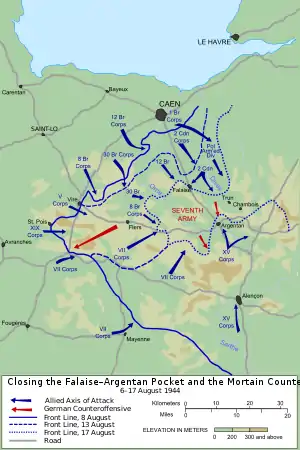
The battle of the Falaise Pocket, fought during the Second World War from 12–21 August 1944, was the decisive engagement of the Battle of Normandy. It takes its name from the pocket around the town of Falaise within which Army Group B, consisting of the German Seventh and Fifth Panzer Armies became encircled by the advancing Western Allies. The battle resulted in the destruction of the bulk of Germany's forces west of the River Seine and opened the way to Paris and the German border. Seizing the opportunity to envelop Field Marshal Günther von Kluge's entire force, on 8 August the Allied ground forces commander General Bernard Montgomery ordered his armies to converge on the Falaise-Chambois area. With the U.S. First Army forming the southern arm, the British Second Army the base, and the Canadian First Army the northern arm of the encirclement, the Germans fought hard to keep an escape route open, although their withdrawal did not begin until 17 August. On 19 August, the Allies linked up in Chambois but in insufficient strength to seal the pocket. Gaps were forced in the Allied lines by desperate German assaults. By the evening of 21 August, the pocket was closed for the last time, with around 50,000 Germans trapped inside. Although it is estimated that significant numbers managed to escape, German losses in both men and materiel were huge, and the Allies had achieved a decisive victory. (Full article...)